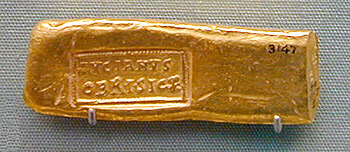History of Gold Bars
Have you ever wondered about the history of gold bars? When we think about gold bars these days, it’s usually the large brick-shaped gold bars that we saw in some movie that come to mind. These standardized bars that weigh 400 oz each are mostly used by banks or other financial institutions and very few mortal souls among us have enough capital to buy one of those, much less several of them.
When gold bars first appeared in the history of humanity, they were shaped like ingots. There are references in Roman history that such ingot-shaped bars had already existed in an earlier period. Pre-Roman gold ingots were never found though so it is also possible that the Roman stories about them were mere legends. What is known is that the respected Roman historian Tacitus mentioned a story by a Cesellius Bassus about a hoard of gold (much of it ingot shaped) in some underground cavern.
The Romans itself used gold bars from AD 367 onwards as a temporary storage solution. All gold coins that were paid in the form of taxes were melted down into gold bars by imperial edict. The purpose of this was to save time in verifying the purity of the gold since it was easier to test a smaller number of larger gold bars than a lot of small individual gold coins. The Roman gold bars of this period that were made out of melted gold coins had assayer’s stamps on them to prevent forgery. The bars were later melted down again to produce new gold coinage so it is no wonder that very few such gold bars have been found at Roman excavation sites.

gold bars from Roman times play a special role in the history of gold bars
In the history of gold bars, the South American country of Brazil also played a special role. It was Brazil where the majority of the world’s gold was mined back in the 18th century. Since 1725, all the gold mined there had to be cast into bars on orders of the government. These gold bars were then shipped to Europe. The bars were of various sizes and it is unknown whether 400 oz gold bars, that are the Good Delivery standard in our time, already existed back then among the variety of cast bars.
Standardization in the history of gold bars
What is known is that some sort of standardization regarding the size and purity of gold bars began at about 1750. Gold bars of 200 oz that contained 91.67% pure gold (a.k.a. crown gold, 22 karat) were the standard at about the year 1810. Good Delivery gold bars of 400 oz may have already existed during this time as well. Written records prove that they definitely existed in 1838 and by the 1890’s, 400 oz gold bars had become the industry standard. For some period between 1810 and the 1890’s, the odd size of 275 oz also seems to have been a standard for gold bars for a while.


